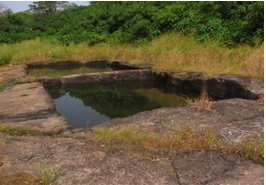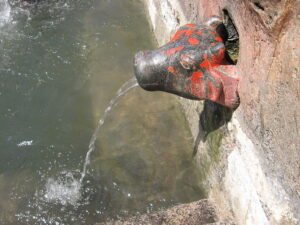
The direct evidence for volcanic origin of Sahyadri comes from presence of hot water springs at scattered sites. They are sulphur-rich springs regarded as holy kundas. These are popularly called, ‘Unhali’ as the water in Kundas is very hot. It is believed that holy bath in these ‘Kundas’ washes all the sins. In a way it is true because sulphur rich water is a good treatment for the skin diseases and also said to cure rheumatism.
Hot Springs in Maharashtra

Vajreshwari
The town here was originally called Vadvali, though now the Goddess Vajreshwari has had her name adopted for the town. Her name literally means “the lady of the Vajra (thunderbolt)”. The original temple of Vajreshwari was at Gunj – five miles north of Vadavli. It was moved to Vadvali after its destruction by the Portuguese. Vajreshwari is at the foot of Mandakini Mountain, which was formed out of a volcanic eruption and it is this proximity that accounts for the many hot springs in this region. There exist several hot springs here.
There are even more hot springs further afield. It is reported that there are around twenty-one hot water springs, just within a five-kilometer radius of the temple. The Tansa River flows through here, rich with its hot waters. The hot springs stretch for about 7 km in the bed of this river, the most well known ones being located here and at the nearby villages of Akloli, Ganeshpuri and Satvalli. The temperature of the water in the springs ranges from 43 C to 49 C. Into most of the springs the locals will jump at once, though there are one or two very hot ones which they do not enter, until first they have bathed in the cooler springs. A couple of tanks in front of a Shiva temple trap the water of seven of the hot water springs. Because the waters are laden with minerals, the water appears blackish.
Akloli Kund

From Vajeshwari one can walk easily to Akloli village, about a kilometre ahead. The springs there are in a wide pleasant valley, clustered round a temple of Rameshwar. Therefore they are called the Rameshwar hot springs. The waters have been gathered into cut-stone cisterns. Back in 1784 it is written that they were much used both by the locals and by the Europeans. In a report of 1786 it was claimed that, except for its lack in a small element of iron, the water tasted the same as the water of the springs at Bath in England. The hot springs at Akloli are located on the left bank of the Tansi River.
Ten hot springs are found here and a concrete tank is located at each hot spring. The hot water temperature of the individual springs varies from 45°C to 48°C. There are provisions for hot showers too. The water of the Surya tank is the hottest.
Ganeshpuri

Ganeshpuri is about 2 km away from Vajreshwari and is also famous for its natural hot springs. Three of the springs are in the bed of the Tansa River, near the temple of Shri Bhimeshvar and they have reservoirs built round them. One of them is called Gorakh Machhindar. Two of the hot springs are in natural hollows in the rock. These springs are usually less crowded than the ones at Vajreshwari.
In Ganeshpuri village just behind the main temple is a small Shiva shrine with tanks in front that hold the water of some of the hot-water springs. The hot water is 52°C. Agni Kund is another hot water spring near the village. The quaint little town revolves around the Nityananda Mandir, built to honour the Saint Nityananda who took Samadhi here, in the 1960s. The temple and its surroundings are still serene, and one can sit peacefully without being harassed. There are some hot springs that bubble up in circular holes melted out of the black volcanic rock there. Ganeshpuri was a wilderness then, surrounded by hills. It was believed that cannibal tribes of jungle folk lived in the region. Nityananda selected a location with many hot springs around it near the ancient temple of Bhimeshwar Mahadev, and for the next twenty five years, he lived there and built it into a spiritual centre.
Nimboli

In the bed of the Tansa river, near the village of Nimboli, are six hot springs, two at a distance of about 175 paces, in stone tanks, and the remaining four springs at a distance of about 200 paces. The water is moderately hot and of a sulphurous smell.
Nimboli is 5 klms from Ganeshpuri. Near Rakadi Baba’s homagund, there is the ancient Anasuya Mata temple and the hot springs. Rakhadi Baba was a holy man who was always smeared in ashes from head to toe. He addressed everyone, even each and every creature of the jungle, as ‘Shiva’. Now he has disappeared off into the Himalayas but his fire remains.
Banganga, Nandni Gaygotha

Three miles north of Vajrabai, in the village of Nandni Gaygotha, is the Banganga spring. All year round this hot spring yields a copious supply of hot and very clear slightly sulphurous water.
Pimplas, Vada
Near the meeting of the Pinjal and Vaitarna rivers, about 1½ miles from Pimplas, in the Vada area, are two hot springs in the bed of the river. During the rains, when the river is full, the springs are not visible. The water is as hot as can be borne by the hand, and has a sulphurous smell.
Sativali

Six hot springs are located on the banks of the Vandri stream which flows a mile from the village of Sativali. The main hot spring (56.3°C) is located on the south bank and small sprouts (59.3°C) are located on north bank of the stream. The water is sulphurous.
There are fragments of a Hindu temple at the hot spring area, with two broken bulls (Nandis), and two broken lingams. This was called the Satoleshwar Mahadev temple. There are three large and three small tanks opposite the temple. The small tank to the left has hot water and steam rises up from it. The other tanks have relatively luke warm water. Some of the tanks are maintained purely for bathing in. The tanks are watched over by the many herons and drongo birds in the vicinity.
Shahapur

At Shahapur there is a holy spring of hot water under a pipal tree. It is called Ganga. Shahapur. Since Shahapur supplies almost the entire drinking water to Mumbai, this town has been declared a No Chemical Zone.
Unhere, Pali

Just 1 km before the Pali Ganesh temple is a hot water spring which is rich in sulphur. It is at the village of Unhere. The hot spring fills three tanks from which there is overflow forming puddles. It is within reach of the town of Nagothane and the village of Pali.
Unhavare, Dapoli

The Unhavare village hot spring is a fascinating spot. It is nestled deep in the heart of a valley on the bank of a picturesque river, surrounded by undulating hills, majestic forest and rolling farm land. On the right side of the river is a dense mangrove forest. The boiling spring water bubbles up from deep inside the earth and cascades down into a series of three rock pools. On its journey it gets cooled by a breeze coming from the river. The hot spring water is clear with just a faint smell and taste of sulphur.
There are shelters there available to people for bathing, separate ones for men and women to take a dip in the rejuvenating hot water. The origins of the hot spring are sacred and therefore this is a holy place that has to be visited barefoot. This small village has the springs as its only attraction and lots of people from the surrounding areas come here regularly to bathe in the hot sulphur water springs. The hot springs are located on the north bank of the creek near the village. There is a large area of marshy ground around the hot springs. Two different sprouts are observed, each spring being in a tank. The main sprout has a temperature of 71°C. Unhavare is situated 20 km from Dapoli. Dapoli was once a British military camp and hence is also referred to as “Camp Dapoli”. Another name for Dapoli is “Mini Mahabaleshwar”.
Unhala, Rajapur

At the village of Unhala, near Rajapur, there is a hot spring. It is located on the flood plain of the Kondavi River, on the southern bank, at the foot of a hill. The hot water of this spring is rich with sulphur. The spring water is also diverted to a constructed bath facility. Rajapur has the most southern hot spring of the west coast geothermal zone
Unkeshwar

In the northern part of the Kinwat region, in the Nanded district, there is a considerable extent of flat land adjoining the river Penganga upon which are situated the hot springs of Unkeshwar(Ushnakeshwar). These springs are spread over an area of 10 square klms from about one mile south of the Penganga River, with temperatures of between 30°and 42°C.
Unkeshwar village is located in a tribal area on the bank of the river. Tourists specifically come to visit two hot springs here called Mukhya Kund and Surya Kund. They are by a Shiva temple. Human habitation in this area has been found for the past 40 to 50 thousand years.
Unapdev, Dara

Unapdev, at the village of Dara, is 3 klms from Adavad, near Chopda town. It is a pleasant picnic spot. The hot water used to emerge from a cow’s mouth, until this was destroyed by a flood in 2007.
The hot spring has a special mention in the ancient ‘Ramayana’ for it was created by Rama during his fourteen years exile.
The word ‘Un-ap’ means hot water. The hot waters collect in a twenty-five feet square pond surrounded by a red-brick wall. Within the enclosure, close to the edge of the pond, there is are two small Hindu shrines and a rest-house. Outside the enclosure the hot water collects into a cattle trough.
Sunapdev and Nijhardev are two other hot water springs in the same area. They are in the Satpada hills. In the Jalgaon area, hot springs have so far been recorded.at Unabdev, Sunabdev and Najhardev in Chopda. There is a fourth one at Vadla in Shirpur.
Salbardi
Salbardi is situated on the Madu river, and is celebrated on account of two springs, one very cold and the other hot. The springs flow into a small stone cistern which was formerly divided into compartments for the hot and cold water. Now they are mixed. Colonel Meadows Taylor who recorded bathing here in 1857 said that the waters gave his malaria temporary relief.
Salbardi holds an important position in Hindu mythology because legend declares it was the abode of Sita when she was deserted by Rama, and that she gave birth to her two sons Lava and Kusa there. Salbardi is about 8 klms north of Morshi.
Indave
Indave in the Sakri region is known is for its small ancient temple dedicated to the Goddess Indai. It is situated on the bank of a lake. Inside the lake there is a built in well holding water and another built in kund nearby which has the hot water spring.
Source
https://www.maharashtratourism.gov.in/maharashtra/hot-springs
http://susiewoo.weebly.com/hot-springs-of-maharashtra.html
http://www.ebdir.net/enlighten/vajreshwari_akloli.html
http://merwynsrucksack.blogspot.in


